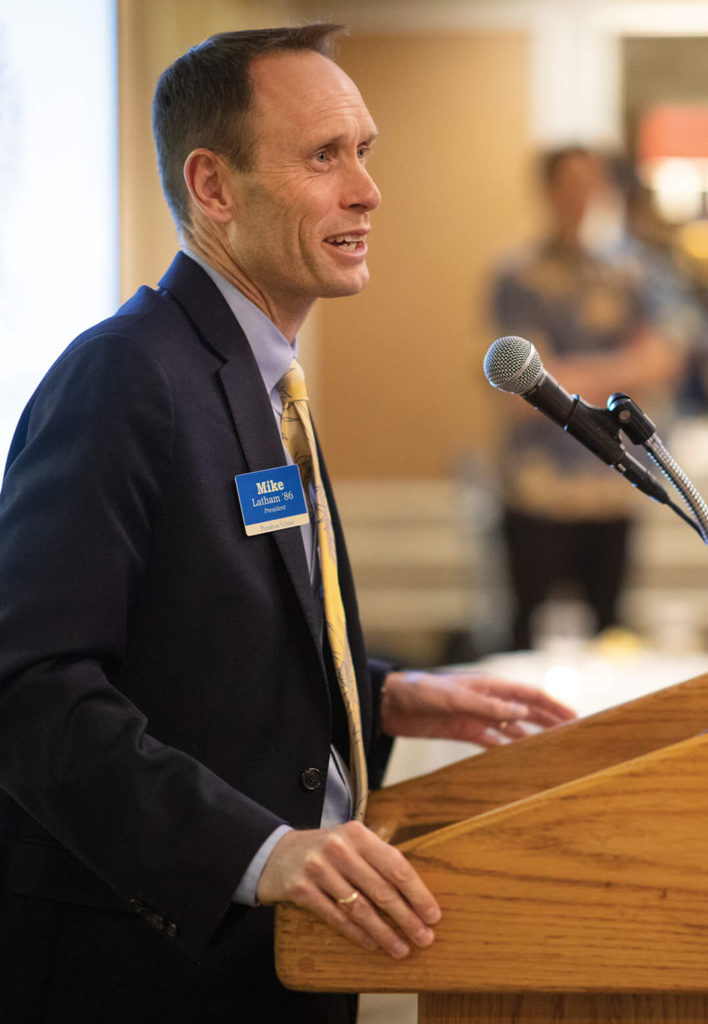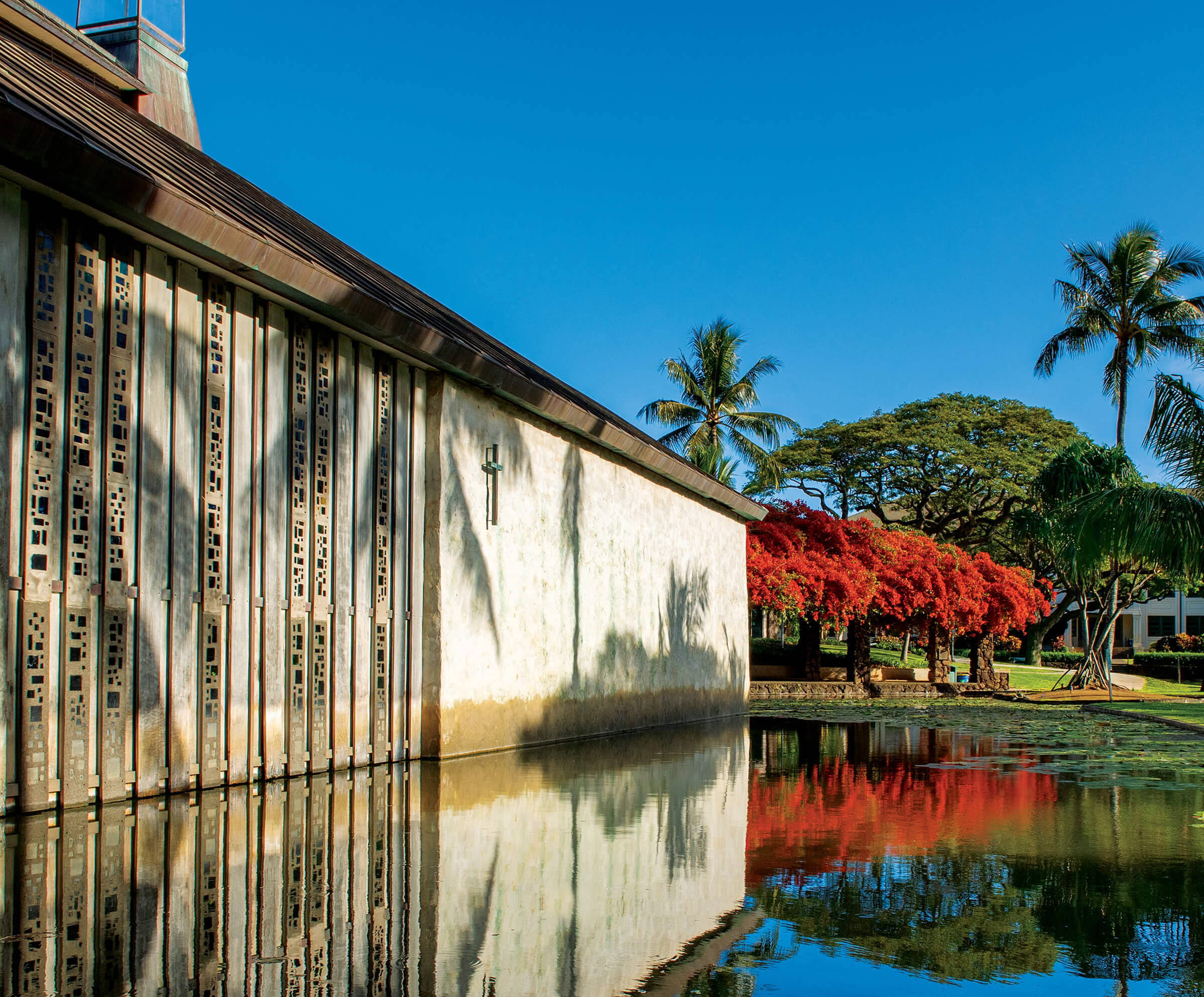By Mike Latham ’86
Outside my office window, Punahou stands in silent beauty. Watching the sun, wind and rain play over the vacant fields, classrooms and libraries of a very quiet campus, I long for the daily sights and sounds of our School. As we comply with government “stay at home” orders and implement a program of distance learning, we miss the annual rituals that bring us together – Holokū Pageant, Junior School May Day Program, spring theatre and musical performances, track meets, volleyball games and alumni gatherings, just to name a few, are all absent. As I write this, in early April, I particularly feel for our senior class. Many of the rites of passage they have looked forward to are impossible to hold amid a coronavirus pandemic, although we still hope to plan a Commencement celebration worthy of their great accomplishments and unity.
While social distancing helps keep us safe, it can also leave us feeling unsettled and isolated. At a moment of anxiety and uncertainty about our health, economy and futures, we long for the companionship and fellowship that inspires, encourages and brings joy to our lives.
I firmly believe, however, that Punahou will meet and emerge from this challenge stronger than ever. Even amid such a disruptive threat, we can still perceive the tremendous energy that makes Ka Punahou, our new spring, such a vibrant and renewing source for us all. At this historical point, we are finding new opportunities to learn, grow and thrive together. Above all, I believe that the current pandemic offers us the chance to reflect on two themes – what a Punahou education should achieve, and what kind of community we wish to create.
We know our students will graduate into a world profoundly different than the one many of us came of age in. Their ability to think, learn and respond to complex, interdisciplinary challenges – drawing knowledge from across multiple fields and collaborating with others to find solutions to complex problems – will be vital. Nothing illustrates this more clearly than the crisis created by COVID-19. While global pandemics aren’t new, the outbreak and spread of this disease clearly demonstrate the profoundly interconnected nature of our world. Framing effective responses to global public health challenges like this one, moreover, requires a deeply interdisciplinary approach. Epidemiology, biology and medical knowledge surely come into play, but so too do questions of public policy, education, history and philosophy. What structures for international cooperation are required to generate a more effective and coordinated response to a global crisis like this one? Should governments rely more on new technologies of surveillance and data integration to manage human behavior, or should they pursue campaigns of education to generate more active and engaged responses by diverse populations? What degree of government intervention in the economy might be necessary to ensure that we produce the equipment, facilities and personnel that public health requires? How have we addressed such questions in the past, and what might we learn from those experiences?
There are no easy answers to these questions, but they are precisely the kind of dilemmas that our students will increasingly confront. Whether we are examining questions of global public health, climate change, food security, renewable energy or elementary education, our students will increasingly need to function in a world where their ability to learn from others and make decisions with imperfect information will be essential. Their emotional intelligence, including their resilience, ability to navigate uncertainty and capacity for empathy, will also be crucial as they work in new environments, engage with different cultures and have productive discussions with people they may profoundly disagree with. Our students will require these capacities in a future workplace shaped by major technological changes and economic shifts. They will also need them to respond to challenges in their own lives, as well as those that disrupt our wider social worlds.
A Punahou education, therefore, must enable students to not only acquire knowledge, but it must give them real opportunities to collaborate with others and put their knowledge into action. It must give them space to apply what they learn to authentic, real-world challenges, and go through the process of testing, failing, adapting and growing.

Our Luke Center for Public Service, Case Accelerator for Student Entrepreneurship, Kuaihelani Learning Center, Wo International Center and our Design Technology and Outdoor Education programs have all enabled Punahou to pursue that goal. As our curriculum continues to evolve, and we create new offerings like our Global Sustainability by Design courses, we will create further opportunities for this kind of engaged learning. The current pandemic, I believe, is an invitation to reflect on the key abilities that our students will require in the future, and to move creatively in response.
At Punahou, our heritage also leads us to create a community shaped by a deep sense of social responsibility. The promise of our School, moreover, is so clearly reflected in the people that our graduates become. As the pages of this magazine reveal, our alumni have responded to the pandemic with great courage, creativity and compassion. I think first of the many health care professionals who are working on the front lines to fight the virus. Critical care physicians like Lina Miyakawa ’04 have treated patients in New York City alongside nurses and therapists, fighting the disease at one of the hardest hit areas in the United States. Other doctors have mobilized to meet the challenge here at home in Hawai‘i, developing the strategy to care for a potentially greater volume of infected patients. Standing directly in harm’s way, alumni like these heroically deliver the services we rely on.
Other alumni have stepped up as well. Punahou Trustee Pierre Omidyar ’84, and his wife, Pam, launched the Hawai‘i Resilience Fund, with additional support from the Hawai‘i Community Foundation and several other philanthropies, to support public health and community-based nonprofits at home. Alumni teamed up with their classmates to collect personal protective equipment for medical professionals. Others have responded to the emergency by creating a network of volunteers to deliver orders of groceries and medicine to elderly Hawai‘i residents who lack transportation or can’t leave their homes. Our alumni have also shared many compelling stories of their ongoing work, and we particularly thank Allen Murabayashi ’90 for producing a dynamic series of podcasts capturing these efforts.
Students and teachers have mobilized too. In early February of this year, even while the virus was still predominantly reported in China, Punahou sophomores and twin sisters Annie and Jaime Wang took it upon themselves to raise funds to help health professionals in Wuhan gain access to vital medical supplies. Taryn Loveman, director of design technology and engineering, and his colleagues have used the fabrication equipment and 3D printers in Punahou’s labs create masks and face shields for physicians and nurses at Hawai‘i Pacific Health and Hawaii Permanente Medical Group. Other faculty like Mark Noguchi ’93 have launched initiatives to ensure that healthy food continues to flow to neighborhoods that lack resources and support.
More widely, the entire Punahou faculty and staff have responded to this challenge with determination, commitment and selfless generosity. Principals Paris Priore-Kim ’76 and Emily McCarren have led our faculty with grace, energy and humor as they have shifted from on-campus instruction to distance learning. Our teachers set aside spring break plans to develop new lesson plans and assignments to take full advantage of online platforms. As we have embarked on distance learning in response to the pandemic, we have also sought to learn from the experiences of our students and parents to continually improve it. Our tremendous team in Information Technology worked around the clock to ensure that our systems would be ready for students, faculty, counselors, deans and our entire instructional force. Our physical plant and custodial teams put in long hours cleaning and caring for our campus as well, ensuring that our environment would be safe. Our Trustees and administrators, moreover, began the work of preserving and deepening our commitment to financial aid and access, ensuring that even in financial turmoil, a Punahou education would be available for as many students and families as possible.
As I compose this column, we remain unsure how long this crisis will last, or what additional preventative measures will be required. We don’t know how large the human toll will be, or what the economic impact will ultimately amount to. I am certain, however, that Punahou will stand strong. And before long, life will return to awaken this quiet campus. Our students and teachers will fill our halls once more, and music, theatre, art and athletics will flourish here again. Together, we will meet this challenge and emerge from it with a deeper understanding of our mission, a more profound recognition of our interconnectedness and greater degree of compassion for each other. I could not be prouder of our School or more grateful for the chance to work alongside you all.

